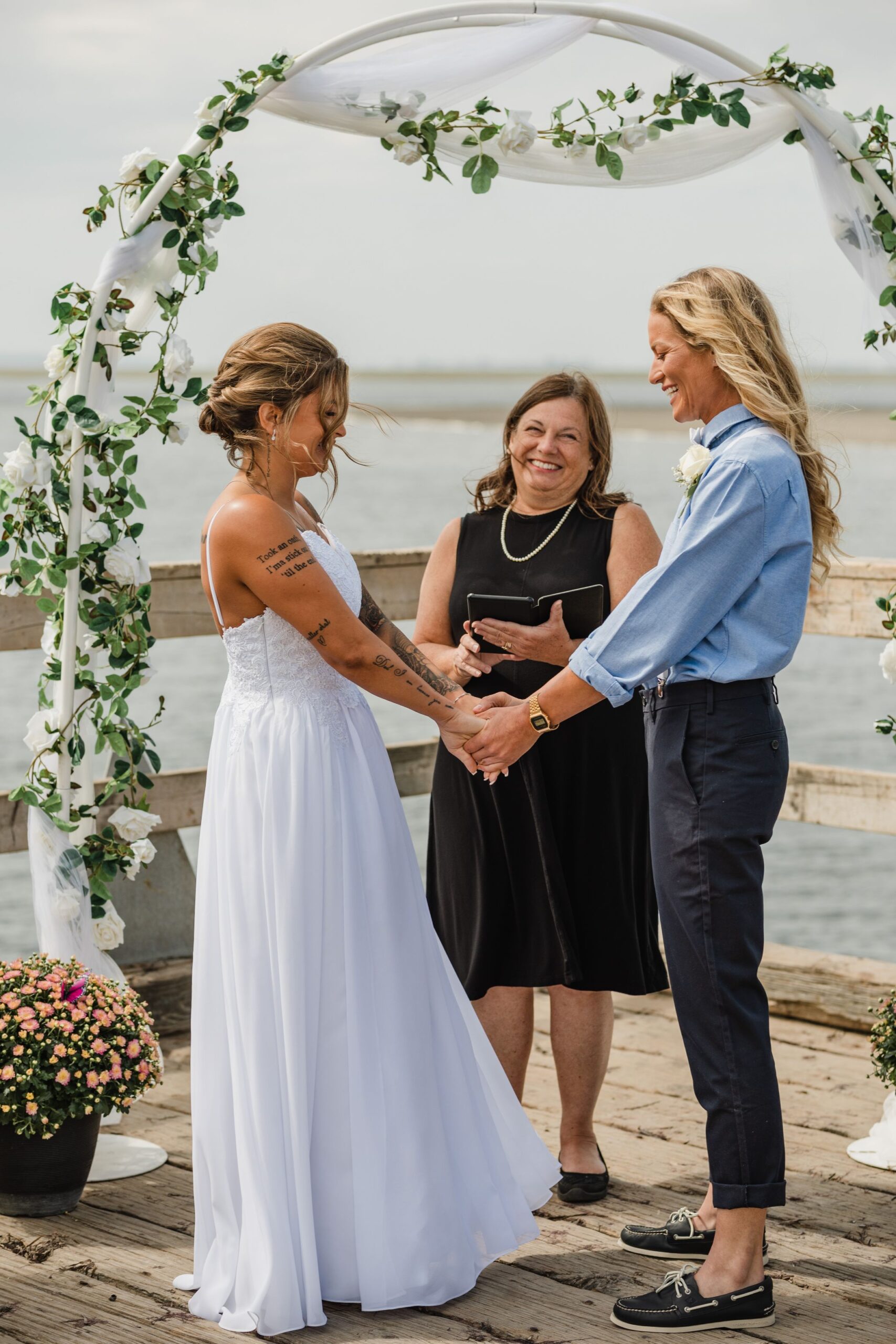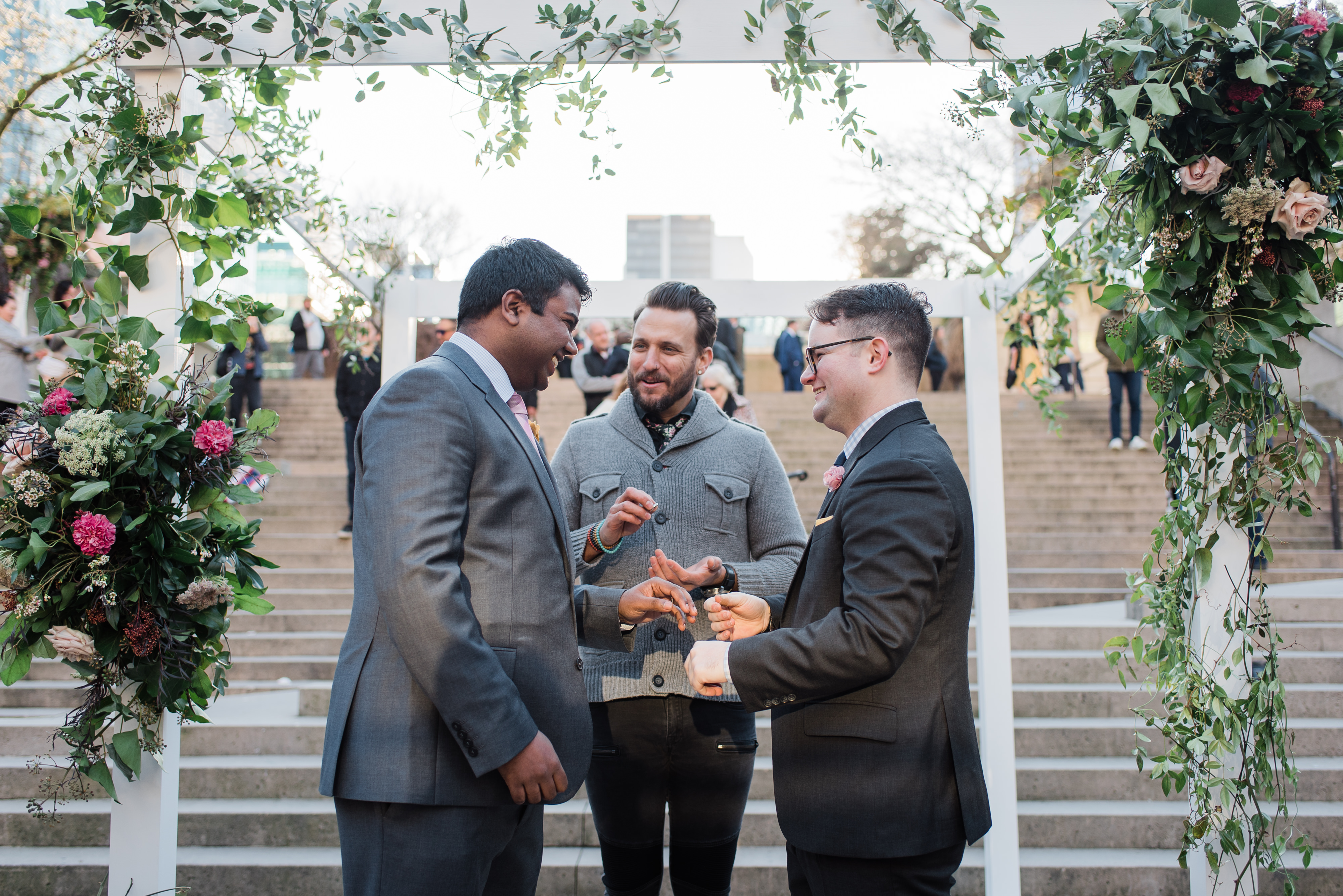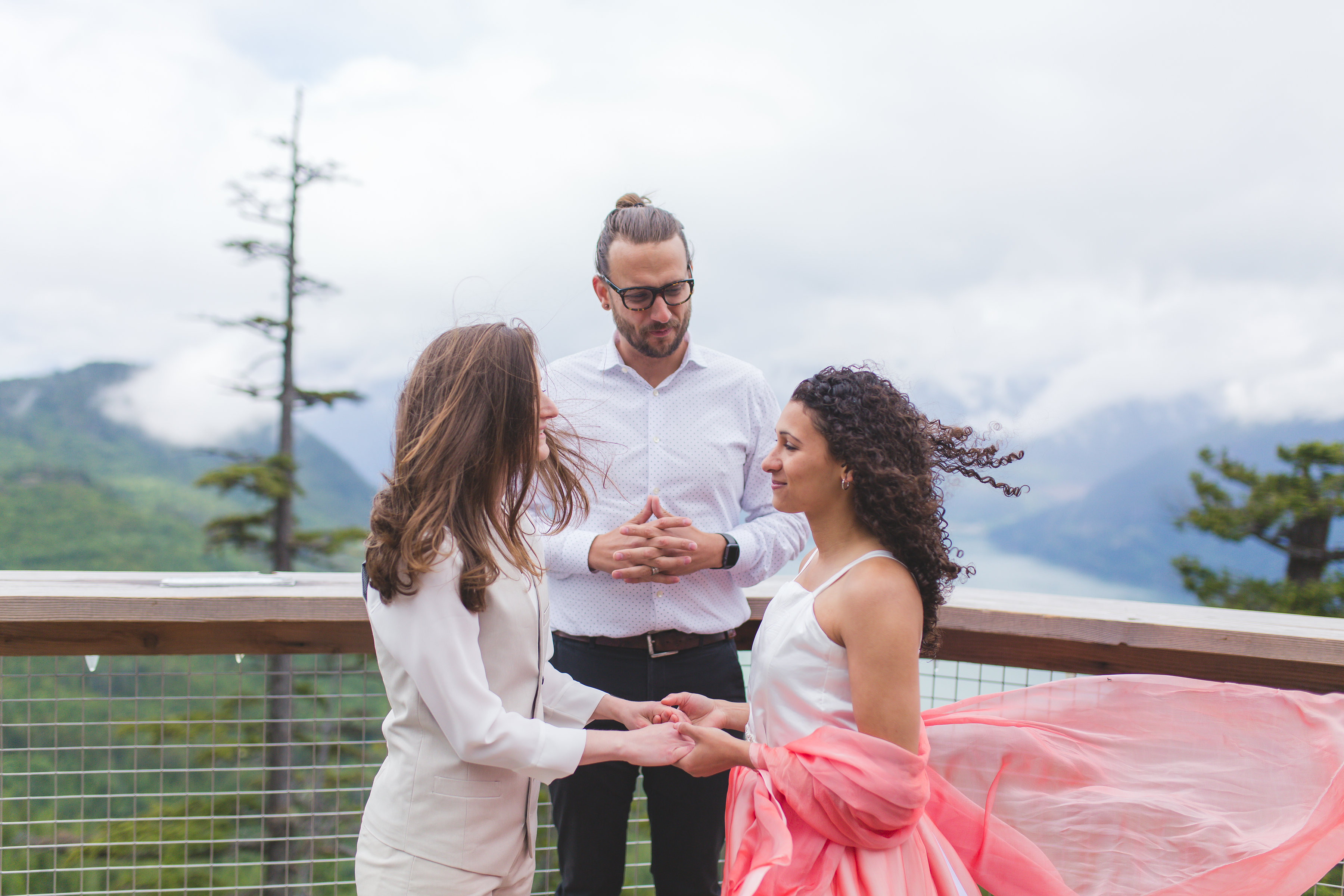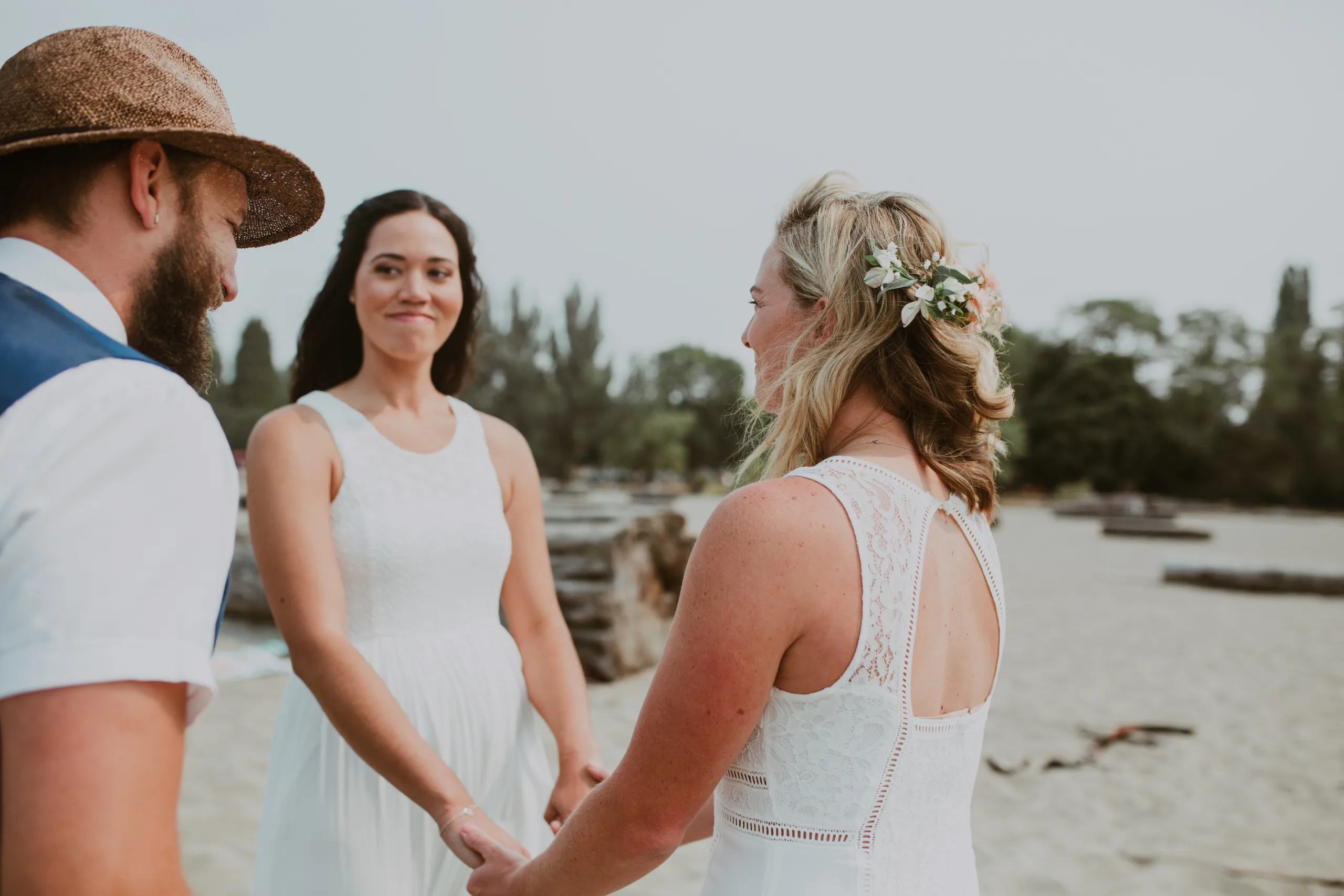We believe that all couples getting married should be able to get married in their way with a ceremony that represents who they are and what is important to them. One large part of that is the ceremony language. A lot of the words you hear at a typical wedding ceremony are outdated, boring and not at all inclusive. Especially for LGBTQ+ weddings, the ceremony language is not always inclusive of the couple getting married.
Well, if that’s the case, there’s no reason to keep those words. If the language of a typical wedding ceremony doesn’t work for you and your spouse-to-be, change it! You can make your wedding ceremony language inclusive, modern and true to you with some easy fixes.
Update: This post was originally published in 2018 using the term “same-sex.” We have updated this post to remove this term as we know it is limiting and exclusionary. Thank you for allowing us to learn and we apologize to anyone who felt excluded by the previous version of this post.
Bride and Groom
In a traditional heterosexual wedding, the terms “bride” and “groom” are used to refer to the couple getting married. If you identify with those terms, go ahead and adopt them for your queer, LGBTQ+, gay or lesbian wedding ceremony language. You can be two brides or two grooms. But if you don’t like the sound of bride or groom, there are other options. You can be referred to as partners, spouses to be, partners for life, or even just by your names!
Husband and Wife
Another hetero term we hear a lot in traditional weddings is “husband and wife.” For many queer weddings, this label isn’t going to fit. Just like bride and groom, you can switch this label to “wife and wife” or “husband and husband.” You can also use less-gendered language such as partners, spouses, soul mates, etc.

Giving Away
A very old school line you may hear at a wedding ceremony is, “Who gives this woman to be married to this man?” It’s asked by the officiant when the bride makes her way down the aisle. Usually, the father of the bride will answer and say, “I do” or “Her mother and I do.” Obviously, this isn’t the most inclusive or feminist language.
So, let’s change it! One option is to change the response to something like, “She gives herself, with the support of her family.” You can also make it more inclusive by asking both partners (and their families) who gives them to be married. You can alter the question; instead of asking who gives the person, because people aren’t property, you can ask who supports this person. And lastly, you can just remove this question altogether from your ceremony!
Defining Love and Marriage
In some ceremonies, the officiant will spend some time reflecting on the meaning of love and marriage, or speaking about the couple. Make sure that your officiant’s words and their definitions of love/marriage line up with your own. Ensure they are making your wedding ceremony language inclusive however they can. There should never be a moment in your own ceremony that makes you raise your eyebrows in surprise or disgust.

Pronouncement
Towards the end of the wedding ceremony comes the pronouncement. A typical pronouncement you might hear is, “I now pronounce you man and wife” or “I now pronounce you husband and wife.” To make the change for your queer, LGBTQ+, gay or lesbian wedding ceremony, you could change “man and wife” to: wife and wife, husbands together, spouses, partners for life, equal partners in marriage, or just married!
The Kiss
After the pronouncement comes the big smooch! The kiss is usually announced as, “You may now kiss the bride.” Sadly, this isn’t the most inclusive or feminist way to start a marriage. Some other options include, “You may now kiss,” “You may seal your marriage vows with a kiss,” “I invite you to start your marriage with a kiss,” and, “Get your smooch on!”
Presentation of the Couple
Once you’ve said your vows, signed your paperwork and sealed it all with a kiss, you will turn to your guests. Traditionally, the officiant will then say, “I present to you, Mr. and Mrs. John Smith,” using the groom’s first and last name. But that’s not how it has to be. You can decide how you want to be introduced as a married couple and what names you’d like to use.
Let’s look at some examples for the marriage of Jane Smith and Betty Doe. “I present to you…
- Jane Smith and Betty Doe
- Jane and Betty Smith/Jane and Betty Doe
- The Does/The Smiths
- Mrs. and Mrs. Doe-Smith/Ms. and Ms. Doe-Smith
- Jane and Betty
- The newlyweds!

Readings, Songs and Your Program
A few more places where you can make your wedding ceremony language inclusive are in your readings, songs and in your program.
With your ceremony readings, you can make sure you’re picking pieces that use inclusive language. Better yet, find readings that speak about important ideals, like equality, and that might even be written by LGBTQ authors. Invite important friends or family members who share these views to do the readings at your ceremony.
In your ceremony music, ensure that the lyrics are inclusive and represent the union you are entering into. Again, you can take it a step further by using songs written and performed by LGBTQ artists that share queer love stories.
Your program is a great place to directly state your views on inclusion, equality and LGBTQ+ marriage. You can share important things for your guests to know or even the use opportunity to acknowledge other queer couples around the world who don’t have the freedom to express their love and marry. You can also include these words on your wedding website or in your officiant’s opening welcome.
The bottom line for planning your queer, gay or lesbian wedding ceremony
For couples planning a queer, LGBTQ+, gay or lesbian wedding ceremony – or any non-cis non-hetero ceremony for that matter – you automatically are confronted with decisions that cisgender, heterosexual couples don’t have to make. For example, a lesbian wedding ceremony may not have a husband or a groom and decisions obviously have to be made about things like last names, aisle walks, etc. There is no traditional default to fall back on.
At the end of the day, we want your ceremony to feel inclusive and welcoming to you. It should represent who you are and what you believe. While the additional labour of making these decisions and not having traditions to rely on is unfair, it can also be an opportunity to design a ceremony that is perfectly personalized to you.
How are you making your wedding ceremony language inclusive?
written by Riana Ang-Canning
feature image by Erica Miller Photography
